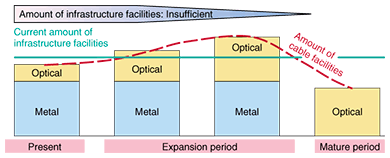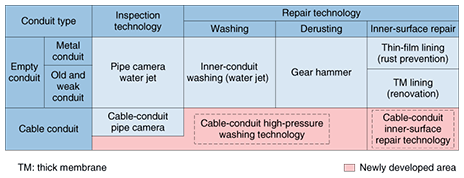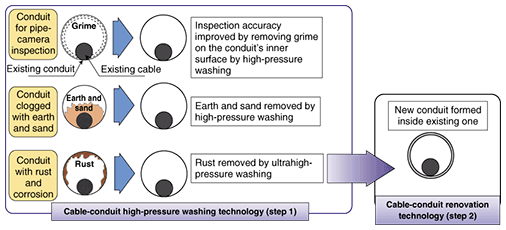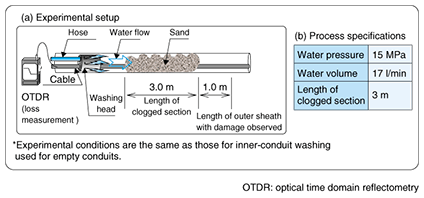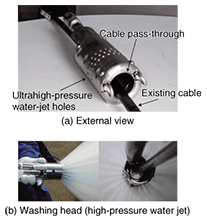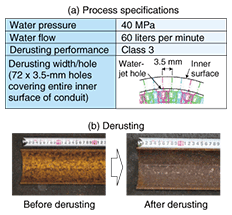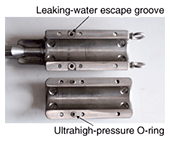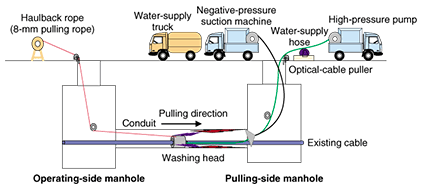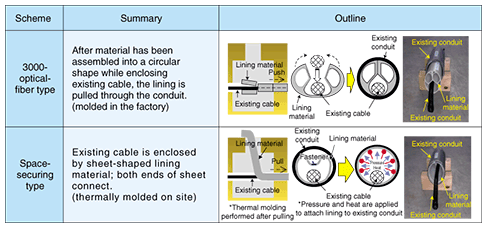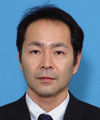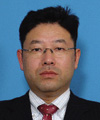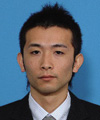 |
|||
|
|
|||
|
Letters Vol. 6, No. 8, pp. 28–33, Aug. 2008. https://doi.org/10.53829/ntr200808le2 Cable-conduit Repair Technology for More Effective Use of Conduit FacilitiesAbstractWe are developing technology for repairing telecommunication conduits without having to dig a trench or affecting existing cables. Inspections performed on conduits designated to accommodate multiple cables have revealed that more than half of them are in a poor condition and require repairs. To date, we have completed the development of a cable-conduit high-pressure washing technology as the first step of this effort.
1. Need for cable-conduit repair technologyAs shown in Fig. 1, the expansion of optical services has led to a period in which both optical cables and metal cables coexist, which increases the demand for conduit facilities. To make more effective use of conduits, multicable laying in which two or more cables are installed in a single conduit is regularly being performed, and a multicable laying process that is upgrading an average of 3000 km of conduit per year is now in place. At the same time, inspections of conduits designated to accommodate multiple cables have found that 59% of them are in a poor condition. In other words, multicable laying cannot be performed for more than half the conduit sections slated to accommodate multiple cables. This state of affairs requires countermeasures, such as changing ducts or taking other routes, increasing the number of conduits, or even repairing conduits containing existing cables by digging them up.
2. Current state of conduit inspection and repair technologiesThe conduit inspection and repair technologies that can currently be used with trenchless methods are summarized in Table 1. For empty conduits that do not accommodate any cables, typical trenchless inspection and repair technologies have been deployed. For conduits with cables, inspection using a pipe camera (video camera) has been implemented. However, if this is used with the inner-conduit washing (water jet) method designed for empty conduits, it can damage an existing cable, so there are times when grime inside a conduit cannot be removed, which prevents accurate inspection being performed. Practical repair technology does not exist for this category, so it has been necessary to dig up roads to make repairs or install new conduits in order to achieve multicable laying when cable conduits are diagnosed as defective. Such excavation work incurs high costs, takes time to complete, and cannot easily provide services in a timely manner. It also results in street work on a relatively large scale, which creates a variety of problems such as traffic jams and noise pollution. In light of these drawbacks, there have been calls to curtail excavation work of this kind. We have therefore been working on the development of technology that can repair cable conduits diagnosed as substandard in a trenchless manner without affecting existing cables. To date, we have completed the development of a cable-conduit high-pressure washing technology as the first step of this effort.
3. Functions needed for cable-conduit repair technologyThe main factor behind the poor state of conduits is rust and corrosion, which affects 97% of substandard conduits. This is followed by clogging with earth and sand affecting 0.4%. In our development, we targeted these two phenomena as well as the need to improve the accuracy of pipe-camera diagnosis in cable conduits. The features and functions required for these targets are summarized below and illustrated in Fig. 2.
(1) Inspection/diagnosis by pipe camera The presence of grime inside a conduit can make it extremely difficult to observe the state of the conduit's wall with a pipe-camera. The inside of a cable conduit currently cannot be washed because of the risk of damaging existing cables. Therefore, the development of a high-pressure-washing method that can clean out a cable conduit safely should lead to improved inspection/diagnosis accuracy. (2) Clogging The accumulation of earth and sand that has found its way into a conduit can decrease the effective cross sectional area of the conduit. This can reduce the space available for multicable laying and prevent new cable from being installed. To deal with this problem without having to dig a trench, we need a way to extract the earth and sand from the conduit by some means such as the high-pressure washing used for empty conduits. (3) Rust and corrosion Rust and corrosion occur due to long-term deterioration of metal conduits. If left unattended, the growth of rust will reduce the effective cross section of the conduit. As a result, it may be harder to pass cables through the conduit, the strength of the conduit may drop due to corrosion wastage of the conduit wall, and holes may occur due to pitting corrosion, causing the conduit to lose its ability to act as a cable protector. To deal with these drawbacks in a trenchless manner, we need two key functions: we must be able to renovate the conduit by forming a new conduit in some way inside the defective conduit targeted for repair even when there is an existing cable and we must be able to remove rust that has grown on the wall of a defective conduit by using high-pressure washing before forming the new inner conduit. We are developing cable-conduit high-pressure washing technology (step 1) and a method for forming a new conduit in an existing rusty/corroded conduit using cable-conduit renovation technology (step 2). These are outlined Sections 3.1 and 3.2. 3.1 Cable-conduit high-pressure washing technology (step 1)3.1.1 Target use: inner-conduit washing to remove earth and sandThis method can clear the conduit of earth and sand and wash the inside of the conduit to the same degree as the inner-conduit washing method currently used for empty conduits. Although the washing equipment itself is the same as that for derusting, it functions at the same water pressure and water volume as the washing method for empty conduits, as shown by the experimental specifications in Fig. 3. This means that, when the purpose is inner-conduit washing of earth and sand, the same pumps etc. as used for washing empty conduits can be used here. To evaluate the washing performance of this method and to check for negative effects such as fluctuation in signal loss of the cable inside the cable conduit or outer-sheath damage at the time of washing, we used the experimental setup shown in Fig. 3.
3.1.2 Target use: derustingWe developed a method that can remove rust using only ultrahigh-pressure water injected from a washing head. The key points of this development work were (i) achieving a balance between the water pressure and the water volume deemed necessary, (ii) achieving sufficient performance for the pump used to supply high-pressure water to the washing head, and (iii) arranging ultrahigh-pressure water-jet holes so that rust would be removed throughout the inner surface of the conduit without missing any spots. As shown in Fig. 4, we arranged 72 water-jet holes in a 3-row format with each hole capable of removing rust across a width of 3.5 mm. A widely used method for rating the degree of rust removal (degree of cleaning) has three levels from class-1 cleaning to class-3 cleaning (highest). Our experiments showed that our technology can perform class-3 derusting, which is considered necessary as preparation for conduit renovation (Fig. 5).
3.1.3 Structure of washing headThe washing head was designed with upper and lower sections that can be separated so that an existing cable can be passed through the center of the head (cable pass-through), as shown in Fig. 4. This structure requires a water channel between these upper and lower sections to convey high-pressure water. As shown in Fig. 6, this channel has ultrahigh-pressure O-rings and grooves that let leaking water escape. The grooves enable high-pressure water to flow outside the washing head in the event of an O-ring failure, thus preventing the cable enclosed by the washing head from being damaged. The cable pass-through is 40 mm in diameter, which can support cables up to 35 mmφ.
The size of the washing head is designed to be less than the dimensions of mandrels used in conduit passage inspections so that the washing head can be drawn smoothly through a conduit. The washing head was also designed to have no sharp angles to ensure that the existing cable is not damaged in any way. 3.1.4 ImplementationThis technology involves pulling an unpowered object through a conduit having an existing cable. In this respect, it is similar to the multicable laying process of inserting an inner pipe, so the know-how gained there can be utilized here. In multicable laying, the established standard states that pulling must be performed at tension no more than 980 N to prevent existing cables from being damaged. In the technology presented here, measures have been taken to ensure that this standard is met. As shown in Fig. 7, this technology is implemented by pulling a water-supply hose connected beforehand to the washing head. The factors affecting pulling tension the most are the friction between the water-supply hose and the existing cable and the friction between the water-supply hose and conduit wall. Any entanglement between the existing cable and the water-supply hose or pulling rope will also increase tension. We decreased the friction by covering the water-supply hose with polyethylene, which has a relatively low coefficient of friction, and decreased the tension by combining the water-supply hose with a fiber-reinforced plastic strength member to increase the rigidity of the hose, thereby reducing the risk of entanglement with an existing cable. In addition, the long shape of the conduit means that water would normally remain inside after washing. Since this water cannot be removed by a swapper or similar tool, as used for empty conduits, a negative-pressure suction machine is used to remove the water.
Considering the delicate work environment inside a cable conduit, we chose equipment and materials for pulling that have a proven record in multicable laying. In addition, work efficiency, such as washing speed and number of workers needed, is about the same as for empty-conduit washing. 3.2 Cable-conduit renovation technology (step 2)After class-3 cleaning, renovation is essential for rusted and corroded conduits. The cable-conduit renovation technology (step 2) is outlined in Fig. 8. This technology is now under development with two schemes slated for implementation: a 3000-optical-fiber type and a space-securing type. The latter uses thermosetting resin as its main material and encloses an existing cable of up to 35 mmφ. After formation of the lining, multilaying can be performed using an inner pipe.
The 3000-optical-fiber type uses factory-molded material having a cable-accommodating space divided into three sections. This scheme is deployed while enclosing an existing cable of up to 35 mmφ. After deployment, a 1000-fiber cable designed with a small diameter can be installed in each of the two remaining sections of the lining material. One advantage of this scheme is the relative ease of obtaining a stable level of quality because the lining material is molded beforehand in a the factory. 4. Future plansWith the development of the cable-conduit high-pressure washing technology (step 1) completed in February 2008, we plan to introduce this technology into business operations. We will continue our work on cable-conduit renovation technology (step 2) with the aim of completing its development by the middle of fiscal year 2008. |
|||








